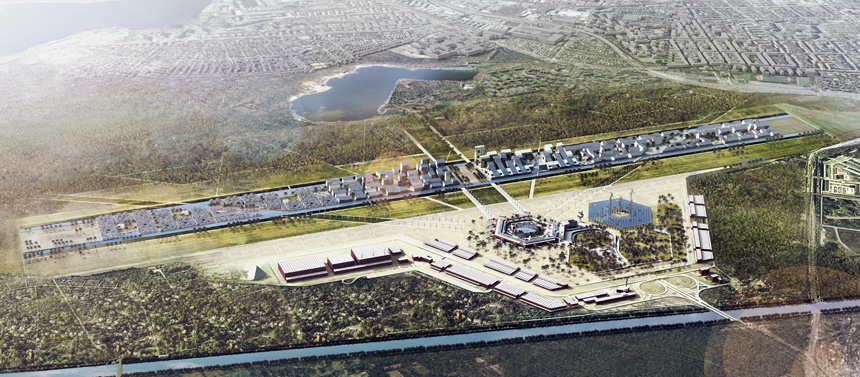
TXL+
Showcase of an energy-plus city
In 2009, twenty award-holders from Germany and China took part in a five-week course at number 13 Planckstraße in Hamburg to work out a scheme for the future use of the 460 ha site of Berlin’s Tegel Airport.
The objective was to develop practicable, future-oriented urban planning and building engineering concepts for an "energy-plus city" that goes beyond the "triple zero" concept in producing more energy over the year than it consumes. The "triple zero" concept refers to projects that on an annualized basis consume no energy, give off no emissions and produce no residues.
The objective was to develop practicable, future-oriented urban planning and building engineering concepts for an "energy-plus city" that goes beyond the "triple zero" concept in producing more energy over the year than it consumes. The "triple zero" concept refers to projects that on an annualized basis consume no energy, give off no emissions and produce no residues.
Twenty selected candidates from the fields of architecture, landscape planning and building services were invited to take part, plus candidates who had had focused experience specifically in energy-efficient planning in the course of their studies, work or teaching.
Contributions from distinguished international visiting speakers (Visiting Professors) provided background information and reports of first-hand experience, to flesh out the subject matter. The Visiting Professors also took active part in assessing the results. Along with the visitors’ lectures, gmp partners and representatives of professional associations and industry also gave talks and reports of first-hand experience.
Preamble
The current controversy about sustainable construction has thrown up two opposing camps. For champions of the "active building" concept, total energy consumed is not the key issue. Instead, they focus on regenerative energy and minimizing consumption by technological means. Meantime, the "passive" approach starts primarily from the idea of minimizing the absolute energy requirement.
Although both approaches have their pluses, the aac aims to work out a position that is as non-ideological as possible. The aac adopts a dialogue approach in an endeavor to find a solution in town-planning and architectural terms rather than purely through technology, i.e. the answer needs to be derived from the location, the function and the social/economic context. This approach draws on the successful model of the European city, but reinterprets it and expands it as a blueprint for sustainable urban development.
The resulting strategy allows for both active and passive models. The criterion for the aac is not the search for a universal solution but identifying diverse architectural approaches that serve the common aim of sustainable urban development.
Background and objective
With the opening of the redeveloped Schoenefeld airport as Berlin Brandenburg International (BBI) in 2011, Berlin’s Tegel airport will be closed. To make the best possible use of the Tegel site and its valuable architectural assets for the future, we have an opportunity to develop a comprehensive strategy as an integral solution for the entire area.
In the light of our current knowledge about climate research and the high proportion of global energy consumption attributable to buildings, at the end of 2008 Meinhard von Gerkan proposed building a city of the future on the former airport site, with construction and utilization following sustainable principles. The former terminal building is to act as a nucleus for this future city, being put to immediate use as a showroom for Germany’s environment industry and constituting long-term the planning center of an energyplus city.
TXL+: An energy-plus city
While mainly pragmatic and simple measures are proposed for the exploitation of the existing site, with as rapid an implementation as possible, the aim of the energy-plus-city of Tegel is to act as a planning model for the future that conforms with the highest architectural, energy and social requirements. The general change of paradigm here is not however a matter of optimizing buildings technically. The new city must generate new forms of living through density and functional flexibility that are structurally conducive to the optimum utilization of energy. As a strip of land defined by the two existing runways, Tegel has a powerful symbolic aura and high recognition value. At the same time, the clearly defined boundaries of the site set markers for a strategy countering land-devouring urban sprawl by means of a compact, high-density urban structure with an excellent quality of life.
Urban density
Optimizing urban density is one of the basic features of TXL+ planning. Putting it into practice has the following benefits:
- reducing traffic
- optimizing the surface:volume ratio per inhabitant
- reducing sealing
- releasing large open spaces (crops, agriculture, returning to nature)
- better-knit social structures, creation of urban quality
- better economic utilization of public infrastructure
-concentration of public institutions
This involves not so much a specific ideal density value e.g. in terms of the floor-space index, as a spatial, social and functional density viewed principally in the context of ist architectural and atmospheric quality. This concept allows for structurally differentiated answers that produce a range of living environments that are nonetheless all high-quality.
Functionally open-ended building structures
A further strategy of sustainability is to create functionally open-ended structures instead of functionally predefined buildings. Long-term, the flexibility resulting from that is as beneficial for energy consumption as for the quality of life in the new city, producing:
• an appreciable lengthening of the life of buildings, as little or no conversion / new-build work is needed for a change of function
• a functional mix, creating urban quality in the process
• the intermeshing of professional and private spheres, further reducing traffic
Triple zero
Along with sustainability of urban development, the buildings themselves need also to contribute to sustainable construction. To this end, a "triple-zero" strategy is pursued, constructing buildings that:
• need no energy to operate on an annualized basis (zero energy)
• give off no harmful emissions (zero emissions)
• are completely recyclable (zero waste)
This strategy enables the whole range of current technical solutions to be exploited, while at the same time making clear that sustainable building is possible only on the basis of high-quality urban and architectural planning.

